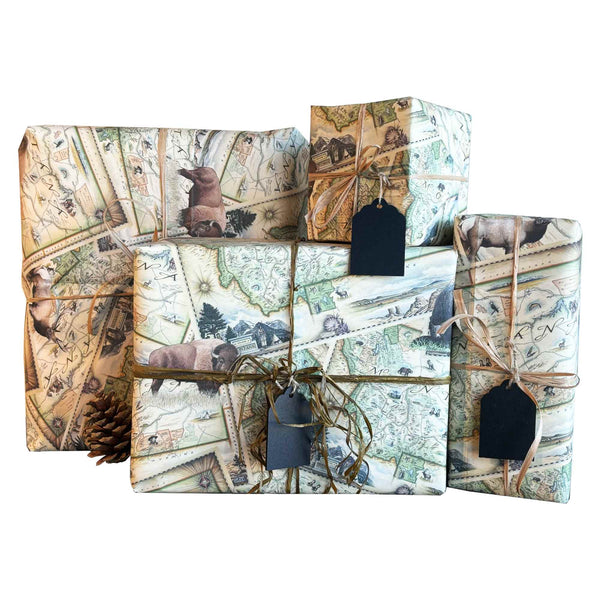Connecting with Southeast Alaska & True Wilderness - Xplorer Maps
Covering the area from the Canadian border just below Prince of Wales Island, north to Yakutat and Cape Suckling, Southeast Alaska is a true wilderness. It encompasses fjords and mountains, a diverse flora of old-growth spruce and hemlock forests, and of course, the iconic glaciers and habitat of Alaskan grizzly bears. Because of its unique beauty particular remoteness and challenging ecosystem, we think of Southeast Alaska as one of the last untamed spots in the world.
But, just as with any wild ecosystem, this Alaskan stretch, including the Tongass National Forest and Glacier Bay National Park, is facing some serious threats. Thankfully, it’s also the home of notable conservation success. In this blog, we’ll cover how to discover Southeast Alaska, its threats, and positive stories.

How to Discover Southeast Alaska
In a previous blog, we saw how powerful navigating down the Colorado River is for experiencing all that the Grand Canyon National Park has to offer. A truly immersive visit to Southeast Alaska, particularly the Inside Passage, takes place down the Alsek River. Flowing from Northern British Columbia to the ocean, the Alsek covers 160 miles in the wilderness. It can be run during a 12-day expedition that will open your eyes to logistical complexities, environmental changes and their impact on the river and the land, and a special communion with wilderness the likes of which are difficult to uncover in many other parts of the world.
A glacial river is particularly challenging to navigate, with extremely fast currents and icebergs breaking off glaciers in real-time. This can cause actual tsunamis - they are the size of buildings, after all! And it’s important to get a sense of scale: the Alsek runs through the middle of the world's largest non-polar ice field, the magnitude of which is difficult to render in images. Along with its tributary, the Tatshenshini River, it delineates a huge protected wilderness area and a UNESCO World Heritage Site.

Alaska’s Alsek River - The Ultimate River Running Experience
Xplorer Maps Storyteller Mandela has guided expeditions down the Alsek River and finds it one of the most unique and challenging experiences in the area (and generally as a river guide). To start, everyone has to go through the mandatory helicopter portage of Turnback Canyon - an extremely remote, difficult-to-access canyon section on the Alsek that presents Class V rapids and can be completely impassable in high water. Guides today do not recommend anyone to portage their gear through Turnback Canyon themselves, along 8 miles of jumbled, crevasse-ridden glacial terrain in an ecosystem rich with grizzly bears.
The first known kayak descent of Turnback Canyon was by Walt Blackadar, who ran it solo on August 25, 1971. His thoughts: “I want any kayaker to read my words well! The Alsek Gorge is unpaddleable! Unbelievable. After carefully scouting the rapids I found it twice as bad as it looks. There’s one huge horrendous mile of hair (The worst foamy rapids a kayaker can imagine), 30 feet wide, 50,000 cubic feet per second, and a 20-degree downgrade going like hell. Incredible! I didn’t flip in the mile or I wouldn’t be writing.” (Written for Sports Illustrated by Walt himself)
Even further down the river, kayakers have to navigate icebergs in whitewater, drastic weather conditions, and complex logistics, all in 24/7 sunlight (which presents its own challenge for sleep and recovery). The Alsek is the most remote, wildest, and most protected river in the world. It requires river guides to be at the top of their game at all times. It has also been a waterway for hundreds of thousands of years, with its mouth having the fifth-largest discharge of water on the west coast of North and South America. Running the river involves crossing some of the most untouched places in our world - a journey of discovery that is worth embarking on at least once in a lifetime. But you need to create your own safety net and be hyper-vigilant doing the trip - it’s truly an expedition where you feel alone and exposed to the raw forces of nature.

CARTOGRAPHY COMES ALIVE - RETURN TO THE ICE AGE: ALSEK RIVER
Join us in the Missoula store on September 25 as Mandela shares her experiences navigating the Alsek River over 12 days and explains the unique, wild nature of the river and surrounding area. FIND OUT MORE
Tongass National Forest
Exploring remote Alaska also includes visiting the unique Tongass National Forest - known as the “crown jewel” of the US Forest Service. It covers 17 million acres and is one of the last remaining intact temperate forests in the world. Not only does it harbor unique species of salmon, brown and black bears, and bald eagles, it is also home to three Alaskan Native nations: the Tlingit, Haida, and Tsimshian.
It’s important to note that there are 19 designated wilderness areas within the Tongass, more than in any other US National Forest. Visitors can explore these on guided hikes, accessing the forest through old logging roads that remind us of the region’s history of timber exploitation.
Hoonah and Icy Strait Point
Another particularly interesting part of Southeast Alaska is Hoonah, situated on the northwest shore of Chichagof Island across Icy Strait from the entrance to Glacier Bay on the Inside Passage. It remains the largest Tlingit community today, with members of the Hoonah Tlingit tribe having lived in this area for thousands of years.
Visitors to Hoonah can use it as a base to explore the open waters of Icy Strait, for fishing or hiking expeditions, or as a break after running the Alsek River. It’s also home to Icy Strait Point, one of the world’s most productive salmon canneries. This is where you can also find a museum and local arts and crafts shops, as well as learn more about the history of fish cannery in the region. Icy Strait Point is one of our partners at Xplorer Maps and an Alaska Native owned-and-operated organization. All profits go directly to supporting the local community. Find out more about the discovery tours and activities they organize here.
Threats to Southeast Alaska
The Inside Passage is a “world in itself” according to those who’ve visited and experienced it. From “big weather” to icebergs the size of buildings, it opens up a different perspective not just into flora and fauna, but also into how climate change is affecting our world. This is why we want to take a moment to look at threats to the unique ecosystem that Southeast Alaska represents.
Transboundary Mining
A major threat to Alaska as well as Montana, Idaho, and Washington, transboundary mining presents potential hazards for the life of animals and humans alike. A recent expert analysis highlighted that six of British Columbia, Canada’s riskiest massive mine waste dams are located on transboundary river systems and are predicted to “destroy ecosystems and/or kill people when they fail.” Climate-fueled floods and disasters are exacerbating these threats, which have become the biggest challenge for wilderness survival in Southeast Alaska.
While indigenous people call the place where transboundary wild salmon rivers originate the “Sacred Headwaters,” the mining industry calls it the “Golden Triangle.” As a result, priorities are difficult to reconcile and local tribes, First Nations, and Alaskan municipalities are all calling for a total ban on mine waste dams and a pause on British Columbian gold mining along the Alaska - BC transboundary rivers until binding watershed protections are put in place.
Notable organizations focusing on the transboundary mining threat include the National Wildlife Federation and Salmon Beyond Borders (the latter based in Juneau, AK). You can read more about the mining report on the NWF’s website and find out about Salmon Beyond Borders’ work here.
Climate Change
Alaska as a whole is experiencing a faster increase in temperature than any other state. The Arctic is warming up at a quicker pace than anywhere else in the world, according to a study published in the journal Communications Earth & Environment. With permanent sea ice steadily shrinking, there is more open water, which absorbs more heat from the sun and, in turn, helps melt more ice.
In Southeast Alaska, glaciers melting are increasing river speeds, and this is impacting navigation on the Alsek, among others. We measure river speeds by cfs (cubic feet per second) and, on a dry day, the Alsek may be flowing at 109,000 cfs, while when it gets hot and there’s more glacier melt it can reach 500,000 cfs overnight. These vast amounts of water are difficult to navigate and make the area extremely hard to predict, too. Whereas in the Grand Canyon, guides know what to expect from the river composition, the Alsek is much more difficult to prepare for.

Clearcutting
The majestic Tongass National Forest, remote enough to be home to so many endangered species of flora and fauna, is at risk of clearcutting and privatization, as per warnings from the Alaska Conservation Foundation.
The Tongass is also an important habitat for wild salmon, which is then linked to healthy populations of brown bears, wolves, and bald eagles (in addition to humans). But logging has been taking place here in an unsustainable manner for decades, so one can only imagine how much more thriving these habitats would be without it. Unfortunately, even areas where nature has reclaimed its space from clearcutting are not moving in the right direction. According to experts, the new growth is impenetrable to wildlife and the slow deterioration of old logging roads has led to erosion filling salmon streams and blocking the way for fish.
Cruise Ships & Extensive Tourism
We’ve spoken about responsible tourism in many of our previous blogs and it’s important to highlight the impact of cruise ships on the Alaskan environment. Most large cruise ships making port there are equipped with exhaust gas scrubbers, a technology that allows them to burn cheaper, high sulfur, heavy fuel oil while still complying with international regulations meant to address air pollution.
Scrubber use has created a serious water pollution problem that needs to be addressed. The wastewater is warmer and significantly more acidic than seawater, and it contains polycyclic aromatic hydrocarbons, nitrates, nitrites and heavy metals like nickel, lead, copper and mercury. All these pollutants affect the health of fish in the water and contribute to increasing water temperatures.
Conservation Success
It’s not all gloomy when it comes to conservation in Southeast Alaska, however. In fact, the very existence of Tatshenshini Alsek Park and protected area, now designated as a UNESCO World Heritage space, is owed to anti-mining activism.
What is today the largest protected biosphere reserve in the entire world started with the Windy Craggy Mine project in northwestern British Columbia. Over three decades ago, the proposed copper mine was poised to become the most environmentally destructive project ever proposed in Canada. It would have sent acid mine drainage into both Tatshenshini and lower Alsek rivers, destroying salmon habitat and having huge effects on animal and human life in the area. The reason it didn't succeed was the concerted effort from conservationists in both the US and Canada. It’s a fantastic example of activism in action and of the importance of fully understanding the impact of resource mining and exploitation in these fragile ecosystems.
There is so much more we could share about Southeast Alaska and connecting with the wilderness out there. However, we can distill this now very long article into two important messages:
- Environmental activism works and can lead to unique, extremely valuable reserves such as the Tatshenshini Alsek Park;
- If you’re looking to experience one of the Earth’s wildest, most remote places, the Inside Passage and Southeast Alaska are a fantastic destination. But don’t delay - climate change is rapidly impacting our experience and the wildlife and geography of this place.

